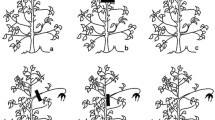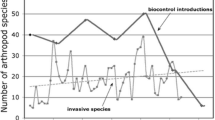Abstract
A model is presented which simulates chemical control against leek rust under a system of supervised control. The spread of disease between fields in one farm and the influx of spores from outside is part of the model. The possible reduction in fungicide sprays against leek rust following various preventive measures is estimated with this model. Results from this preliminary model suggest that supervised control of leek rust will result only in a considerable reduction in the number of fungicide sprays if the leek fields are sufficiently isolated and the planting material is initially disease free. Where isolation between the fields is not feasible, overlap between successive crops should be avoided. Without the use of these preventive measures, there is little prospect for supervised control and the grower will have no option but the heavy use of fungicides.
Similar content being viewed by others
References
Albert J and Smolka SE (1994) Die Erreger des Rostes anAllium-Arten und Beobachtungen zur physiologischen Spezialisierung vonPuccinia allii an Porree. Mitt and Biol Bundesanst 301: 138
Aylor DE (1987) Deposition gradients of urediniospores ofPuccinia recondita near a source. Phytopathology 77: 1442–1448
Boudreau MA and Mundt CC (1992) Mechanisms of alteration in bean rust epidemiology due to intercropping with maize. Phytopathology 82: 1051–1060
Conway GR (ed) (1984) Pest and Pathogen Control: Strategic, Tactical and Policy Models. Wiley — International Institute for Applied Systems Analysis, 488 p
Fitt BDL, Gregory PH, Todd AD, McCartney HA and MacDonald OC (1987) Spore dispersal and plant disease gradients; a comparison between two empirical models. J Phytopathology 118: 227–242
Jennings DM, Ford-Lloyd BV and Butler GM (1990a) Rust infections of someAllium species: an assessment of germplasm for utilizable rust resistance. Euphytica 49: 99–109
Jennings DM, Ford-Lloyd BV and Butler GM (1990b) Effect of plant age, leaf position and leaf segment on infection of leek rust,Puccinia allii. Plant pathology 39: 591–597
de Jong PD (1994) Growth of leek rust epidemics in time in three cultivars during the early stage of the epidemic. Eur J Pl Path 101: 139–148
de Jong PD (1995) Sampling for detection, leek rust as an example. Int J Pest Management (in press)
Kiyosawa S and Shiyomi M (1972) A theoretical evaluation of the effect of mixing resistant variety with susceptible variety for controlling plant disease. Ann Phytopath Soc Japan 38: 41–51
von Meyer W and Kessler H (1990) Ansätze für einen integrierten Pllanzenschutz bei Porree. Gesunde Pflanzen 42/9: 295–300
Niks RE and Butler GM (1993) Evaluation of morphology of infection structures in distinguishing between differentAllium rust fungi. Neth J Pl Path 99 Supplement 3: 139–149
Nyrop JP, Shelton AM and Theunissen J (1989) Value of a control decision rule for leek moth infestations in leek. Entomol exp appl 53: 167–176
Smith BM and Crowther TC (1992) Field assessment of the reaction of leek cultivars to leek rust. Tests of Agrochemicals and Cultivars 13. Ann appl Biol 120(Supplement):104–105
Theunissen J (1984) Supervised pest control in cabbage crops: theory and practice. Mitteilungen aus der Biologischen Bundesanstalt für Land-und Forstwirtschaft 218: 76–84
Uma NU and Taylor GS (1991) Reaction of leek cultivars to infection byPuccinia allii. Plant Pathology 40: 221–225
Weisz R, Smilowitz Z and Christ B (1994) Distance, rotation and border crops affect colorado potato beetle (Coleoptora: Chrysomelidae) colonization and population density and early blight (Alternaria solani) severity in rotated potato fields. Journal of Economic Entomology 87: 723–729
Author information
Authors and Affiliations
Rights and permissions
About this article
Cite this article
de Jong, P.D., Daamen, R.A. & Rabbinge, R. The reduction of chemical control of leek rust, a simulation study. Eur J Plant Pathol 101, 687–693 (1995). https://doi.org/10.1007/BF01874873
Accepted:
Issue Date:
DOI: https://doi.org/10.1007/BF01874873




